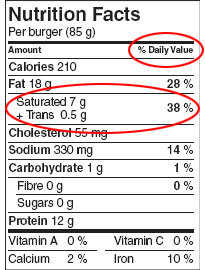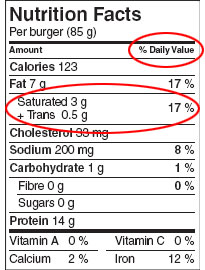
Tips for Meat and Alternatives
There are many different foods to choose from in the Meat and Alternatives group. Vary you choices each day and throughout the week. There are many delicious ways to prepare meat and alternatives. Find out more about:
Choosing Meat and Alternatives
Use these tips wherever you are - at home, at school, at work or when eating out!
Have meat alternatives such as beans, lentils and tofu often.
- Meat alternatives are an inexpensive source of protein
and are high in fibre and low in fat.
- Use dry roasted nuts and seeds without added oils or salt.
Eat at least two Food Guide Servings of fish each week*.
- Choose fish such as char, herring, mackerel, salmon, sardines and trout. These types of fish are particularly high in omega 3 fatty acids which have been found to have heart health benefits.
- Plan your meals ahead of time to make sure you have two Food Guide Servings of fish each week.
* Health Canada provides advice for limiting exposure to mercury from certain types of fish
Look for lean meats including beef, pork, veal, lamb and game meats such as moose, caribou and deer. Lean or extra lean cuts of meat include inside round roast, outside round roast, eye of round steak or roast, strip loin steak, sirloin steak, rump roast and lean and extra lean ground meat or ground poultry.
Processed luncheon meats, sausages and prepackaged meats are usually high in fat and salt (sodium). If you eat them, choose sodium reduced and lower fat varieties if available.
Buy fresh or frozen meat, fish and poultry without breading or rich sauces.
Choose nuts, nut butters and seeds in small amounts. One Food Guide Serving is 60 mL (¼ cup) nuts and seeds and 15 mL (2 Tbsp) for nut butters.
Top of page 
Treat Your Taste Buds
- Use peas, beans and lentils in place of meat several times a week. Add them to soups, casseroles, salads and burritos, or mash them into dips.
- Experiment with different soybean based foods like tempeh and edamame (soybeans).
- Order the catch of the day when eating out. Choose fish seasoned with herbs and lemon rather than a rich sauce. Go for fish that is broiled, poached, grilled or baked, rather than breaded or deep fried.
- Use herbs and fresh salsas instead of salt to season and flavour fish, meats and poultry. Try rosemary with chicken or fresh mango salsa with pork.
Top of page 
Read Food Labels
All the information on the Nutrition
Facts table is based on a specific
amount of food. This amount may be different than one Food Guide Serving.
You can use the Nutrition Facts table to:
- Compare products more easily;
- Determine the nutritional value of foods; and
- Help you choose a product with more or less of a particular nutrient.
Use the food label on packaged products to select meat and alternatives prepared with little or no added fat or salt.
For example:
When comparing two similar products you can use the % Daily Value to see if a food has a little or a lot of a nutrient.
Product 1
Beef Burger |
Product 2
Lean Beef Burger |
 |
 |
In these examples, Product 1 has a 38% Daily Value for saturated fat and trans fats while Product 2 has a 17% Daily Value for saturated and trans fats for the same serving size amount. Product 2 is lower in total fat, saturated fat and calories and in this case sodium.
Top of page 
Preparing Meat and Alternatives
Prepare meat and alternatives that
taste great!
- Use canned beans for convenience or soak and cook dried beans or lentils when you have the time. Experiment with navy, kidney and black beans, chick peas, and lentils (red, green or brown).
- Top a salad with beans, lentils, chick peas, a hard boiled egg, nuts or seeds.
- Cut up and cook small strips or pieces of meat, poultry or fish to add to stir fries, stews, soups or salads.
- Wrap a chicken breast or fish fillet along with vegetables and herbs in aluminum foil, and bake in the oven or on the barbecue.
- Add canned salmon or tuna to pasta dishes or salads.
- Enjoy eggs scrambled, poached, boiled or in omelettes and frittatas.
- Make your own trail mix by combining your favourite cereal and dried fruit with a handful of unsalted nuts and sunflower seeds.
- Enjoy a small handful of nuts or seeds for a snack or toss them into salads or stir-fries for extra flavour and crunch.
Select lean meat and alternatives prepared with little or no added fat or salt.
- Trim visible fat from meat and skin from poultry before cooking. Drain off extra fat after cooking.
- Cook meat, poultry, fish or shellfish by baking, grilling, broiling, poaching or microwaving instead of frying or deep-frying.
- Serve meat, poultry and fish without rich sauces, butter or gravy.
- Use small amounts of oil when cooking meat, poultry, fish, shellfish or eggs. Learn more about cooking with oils and fats.
- Add less salt when cooking. Flavour foods with lemon, herbs or spices instead of salt. Use lower-sodium broths and bouillon cubes. Taste foods before adding salt and use less salt at the table.
Keep meat and alternatives fresh
and safe to eat
- Store eggs in their carton to maintain freshness and use by their "best before" date.
- Use fresh meat, fish or poultry within two to three days after buying or freeze until you are ready to cook.
- Keep raw meat, fish and poultry well wrapped and stored on the bottom shelf of the refrigerator to prevent juices from dripping on other foods.
- Cut and prepare raw meat, fish and poultry on a separate cutting board from that used to cut ready to eat vegetables, fruit or other foods.
- Cook all meat thoroughly. Use a meat thermometer to ensure that meat has been cooked to a safe temperature. Make sure no pink remains in ground meat. Undercooked hamburger may contain E. Coli bacteria which can cause serious illness.
- Use a clean platter for cooked meat, fish or poultry. Do not use the one that held the raw meat, raw fish or raw poultry prior to cooking or barbecuing.
- Defrost meat, poultry and fish in the refrigerator overnight and not on the counter. This will prevent bacteria from multiplying as the food defrosts. If using the microwave to defrost meat, poultry or fish, cook the meat immediately after thawing.
- Check package labels and use food before the "best before" date.
- For information or advisories on sport fish caught in local waters, check with your provincial or territorial authority.
Learn More About:
Additional Resources:
|
